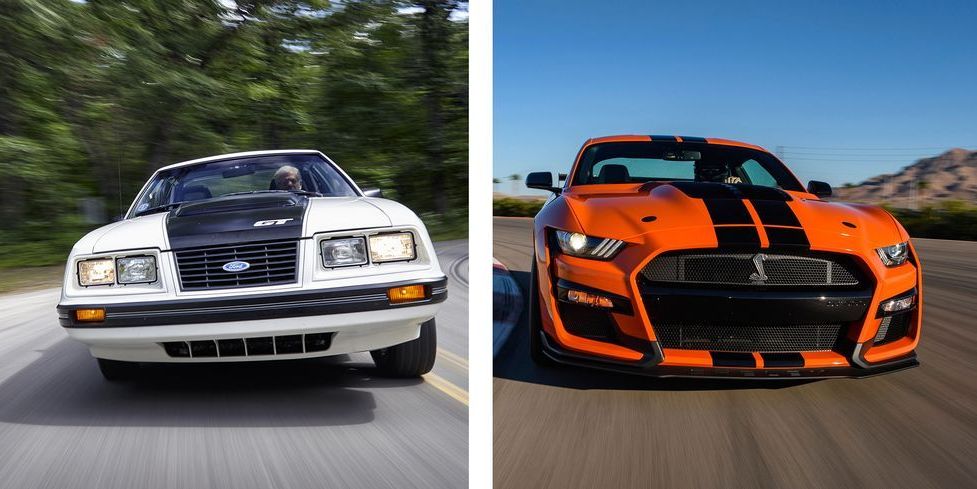Ford Mustang: A Brief History in Zero-to-60-MPH Acceleration

Greg Pajo and FordCar and Driver
Over the years, we’ve tested a plethora of American muscle cars and have been there for each drastic refinement since the 1960s. Straight-line speed is one obvious improvement. And it’s unfair to describe muscle cars as one-trick ponies, as they’ve started carving up corners at speeds unthought of even 10 years ago. Especially because some of today’s Mustangs are fully-electric. But, if you’re looking at a benchmark that accurately reflects how much a single model, such as the Ford Mustang, has improved over the past few years, you can’t go wrong with the old-fashioned zero-to-60-mph time*. It’s easily relatable and comparable, unlike a skid pad number or a Nürburgring lap time.
Thanks to our extensive history of gathering our own performance data, we have decades of revealing numbers captured by our editorial staff that not only offer a unique look into a vehicle’s evolution but also serve as a performance barometer of sorts for any given era. Jump in and flip through more than five decades of Mustang acceleration numbers pulled from some of the hottest (and not so hot) performance ponies ever strapped with C/D test equipment.
*Acceleration times using 3-mph rollout, not our current rollout standard of 1 foot with the exception 2020 Ford Mustang Shelby GT500 and newer.
Advertisement – Continue Reading Below
It’s easily the best thing to come out of Dearborn since the 1932 V-8 Model B roadster. But for all Ford’s talk of Total Performance, it’s still clear that the Mustang has been designed and built to a price. The necessity of meeting cost goals meant that it had to share a maximum number of components with other models in the Ford line. Out of this situation sprang the advantage of an extremely wide availability of options for the Mustang, selected from the Falcon, Fairlane, and Galaxie series.
FULL MUSTANG CONVERTIBLE TEST RESULTS
You’d think that dropping an anchor like the 390 engine into the Mustang would overload the front end and make it handle like a real dog, wouldn’t you? The puristi will glance at the specs and hoot derisively at the 60.3/39.7 percent weight distribution and tell you the rig will never fly, right? In truth, even we expected the Mustang 390 GT to plow like an Ohio farmer. It doesn’t. The car we tested had over 400 pounds more weight on the front wheels than the last Mustang we tested—a 271-hp 289. There have been no basic changes in the Falcon-inherited suspension, yet the Mustang 390 GT has balance and handling.
FULL MUSTANG GT TEST RESULTS
The Mustang engine was all business. No chrome air cleaner or valve covers. Just plain old blue paint. Even the headers were kind of pale blue. Right on top was a super-tall aluminum, two 4-barrel inline intake manifold with a pair of 540-cfm Holleys and a paper-element air cleaner. There it was, tunnel-port fans, right in front of our very eyes. The real thing. “Well, yes, this is your regular 12.5 to 1 compression ratio, dry-deck, tunnel-port 302,” allowed Ford Man, still a bit defensive from the tire discussion. “How many do ya want?”
FULL MUSTANG TEST RESULTS
It may just be that this time the stylists have done too good a job. Look at the Mustang Mach I, and you expect miracles—drive it, and they are not forthcoming. The pieces are there—most of them anyway—but the sum is far short of its parts.
FULL MUSTANG MACH I TEST RESULTS
To race or not to race? Ford has finally decided. Not to. With all the pressure from ecologists and auto-safety advocates, Ford was finding it impossible to justify dropping four or five million at the tracks every year where people could see it. So no more racing. That sort of leaves the Boss 351 dangling from the end of the limb that has been cut off. The main purpose of its existence has been to fulfill the SCCA production requirement so that the factory racers would have something from which to build a juggernaut for the Trans-Am. But if the factory isn’t going to race them, who will?
FULL MUSTANG BOSS 351 TEST RESULTS
While the Mustang II shares some standard components with the Pinto, it is not just another version of that economy sedan—no more than the original Mustang was simply a Falcon. It has been built with the specific intention of coming into the market as a Super Coupe and, in terms of “feel,” it’s a success. As opposed to the sterile practicality and cost-trimming measures so dispassionately evident in American-made economy cars up to this time, the Mustang II in no way seems to be a cheap car.
FULL MUSTANG II MACH I TEST RESULTS
You can’t deny its initial appeal—a glorious sobriquet from the past, Carroll Shelby paint job, scoops, spoilers, white-letter tires, V-8 motor, and four on the floor. Sounds neat, but what you get is a mini Mark IV all dressed up in performance gear with nothing to make it go. Your mother-in-law deserves more than 105.7 mph. To strangle a 302-cubic-inch motor down to a sickly 134 horsepower is an amazing—but embarrassing—feat of modern technology.
FULL MUSTANG COBRA II TEST RESULTS
First the bad news: The big motor’s gone. We say “big” with tongue firmly planted in cheek, because 1979’s 302-cubic-inch V-8 sucking life through a two-barrel straw was hardly what you’d call muscle-bound. Nevertheless, this year’s plan is a smaller cylinder bore and less displacement to wring one more mile out of every precious gallon of gas. The new, 255-cubic-inch (4810 cc) V-8 also trims 25 pounds off front-end weight. What this costs you is roughly 10 horsepower compared with the 302 V-8’s 140 net horsepower output. Ford claims the change brings a fuel-economy improvement of 1.2 mpg.
FULL MUSTANG COBRA TEST RESULTS
Press on the Mustang’s gas pedal, and great things happen. An authoritative growl from under the hood is accompanied by screeches of rubber at the back of the car. This Mustang is at the moment the quickest machine made in America, and our internal sources at the Ford Motor Company suggest that efforts are afoot to keep Mustangs and Capris that way.
FULL MUSTANG GT TEST RESULTS
The third-gen Mustang GT marked the start of a long climb out of the Dark Ages for American carmakers. Two oil shortages in the previous 10 years and the ratcheting up of emissions standards had diverted engineering resources into building smaller, more efficient cars. By 1983, though, the Camaro/Mustang performance race was on again. That rivalry was, like now, about more than just straight-line speed, so Ford also retuned the ’83 GT’s suspension for better handling and widened its Michelin TRX rubber for more grip.
FULL MUSTANG GT TEST RESULTS
Now that the year-old redesign of the Ford Mustang has some miles on it, both Ford and the Mustang’s obsessed clientele are ready for a few important changes. A Mustang Cobra making more than 300 horsepower is certainly welcome. And finally banished from the ’96 Mustang GT is the ancient overhead-valve 4.9-liter V-8, which—in various guises—has powered Mustangs since their inception. Certain purists may wail and gnash their teeth over this one, but it’s a transition we like.
FULL MUSTANG GT TEST RESULTS
Who ever thought a factory Mustang would command a price of $28,000? More surprising, who could have imagined that a Mustang would have an independent rear suspension? Well, the 1999 SVT Mustang Cobra lays claim to both those surprises and makes a strong case that the latter (abetted by a new 320-horsepower version of the four-cam, aluminum-block 4.6-liter V-8) justifies the former.
FULL MUSTANG SVT COBRA TEST RESULTS
The Mach 1 earns its silver medal because it is brute fun. Drop the hammer, and with no especially refined technique, 60 mph is yours in a scalding 5.2 seconds, just 0.7 second behind a $34,750 SVT Cobra and the fastest time in this test by a full half-second. The first two shifts of the notchy box leave skid marks, and the fourth shift puts paid to 151 mph.
FULL MUSTANG MACH 1 TEST RESULTS
It doesn’t happen often, but the hens in the henhouse sometimes kill the fox. That’s apparently what happened over at Henry’s glass henhouse in Dearborn. The GT’s 4.6-liter SOHC modular V-8 now features 24 valves rather than 16. The three-valve heads permit an increase of 40 horses and 18 pound-feet of torque, although both improvements are realized at loftier revolutions.
FULL MUSTANG GT TEST RESULTS
Remember when 540 horses were enough to win Indy or set a Bonneville record? The Shelby lunges forward with a fearsome roar when you mash it, the acceleration making you startlingly heavy in the seat. Even so, Ford thought our 12.9-second quarter-mile was slow by a half-second, but after two test sessions in imperfect conditions—and after letting Ford’s own hot shoe take the wheel—we were unable to better the times. Ford figures the car should run 12.5-second quarters, maybe quicker. Maybe so—we await the proof. Meanwhile, it’s no quicker than a Chevy Camaro SS, which is about $17,000 cheaper.
FULL MUSTANG SHELBY GT500 TEST RESULTS
The 412 horsepower and 390 lb-ft of torque, the latter on a gloriously flat curve that peaks at 4250 rpm, are achievements. It’s enough to knock out a 60-mph sprint in 4.6 seconds, and the quarter-mile in 13.2 seconds at 109 mph, which are more or less Camaro SS times. Finally, a Mustang engine that doesn’t have to eat dust from a small-block.
FULL MUSTANG GT TEST RESULTS
Two. That’s how many times this author looked underneath the 2013 Boss 302 Laguna Seca to make sure some crafty Ford employee hadn’t replaced the solid axle with a fancy-pants independent-rear-suspension setup. It’s not as if the Boss were suddenly devoid of axle hop or radically more skilled at navigating off-camber curves and uneven pavement than are other current Mustangs, but Ford has finessed the stick axle to the point where it no longer spoils an otherwise good time. Still, we wanted to be 100 percent sure the company hadn’t slipped us a ringer.
FULL MUSTANG BOSS 302 TEST RESULTS
With a car like this, you inevitably focus on the numbers. The $54,995 GT500 coupe turns in a zero-to-60-mph sprint of 3.5 seconds. Ferociously tall gearing means third gear is good for 140 mph and first gear is long enough to reach highway speeds. Even so, the quarter-mile passes in 11.8 seconds. Slam a redline shift from second to third, and you’ll hear the rear tires chirp. We also saw an even 1.00 g on the skidpad.
FULL MUSTANG SHELBY GT500 TEST RESULTS
With a six-speed manual sprouting up between the seats, the V-8 makes very short work of the first three gears. The accelerative rush is such that the somewhat cheesy Ground Speed label on the speedometer makes some sense, and the needle swings into triple digits very quickly. Zero to 60 mph is accomplished in 4.5 seconds, and the quarter-mile lights tripped in 13 flat; our Mustang also hit 150 mph in well under 30 seconds. Also, there’s no Muzak version of the Daytona 500 played through the speakers in the Mustang. The GT’s V-8 soundtrack, although more subdued than we expected, is generated solely by combustion events and not electrons. We came away from this hushed GT thinking about refinement, not tinnitus.
FULL MUSTANG GT TEST RESULTS
Not that the new Shelby isn’t quick, but it’s not a dedicated quarter-mile eater, either. The base GT350 reaches 60 mph in 4.3 seconds after a somewhat difficult launch and does the quarter-mile in 12.5 seconds at 117 mph. Perhaps not stunning numbers these days, but the test car did weigh 3796 pounds. With its 18-pound carbon-fiber wheels and stickier Michelin Pilot Sport Cup 2 tires, the R (at 3710 pounds) makes it to 60 in 3.9 seconds and through the quarter-mile in 12.2 seconds at 119 mph. Guess what? Porsche 911 GT3 drivers don’t jump up and down about drag-strip times. Stats that matter to them more are skidpad grip and braking distances. There, the 350 and 350R pull 0.98 g and a startling 1.10 g, while stopping from 70 mph in 152 feet and 146 feet. Ford’s priorities become clear when you check the track-sheet data.
FULL MUSTANG SHELBY GT350 TEST RESULTS
The Ford Mustang’s punchy turbocharged 2.3-liter inline-four EcoBoost engine was available with its own Performance Pack for the 2018 model year, and like today, comes with a 10-speed automatic. If you recall, the last EcoBoost we tested was a 2015 example that had four fewer gears to mess around with. The extra speeds help in a straight line, as the 2018 EcoBoost goes from zero to 60 mph in 5.0 seconds flat. That’s an improvement of 0.2 seconds over the 2015 model.
FULL MUSTANG ECOBOOST TEST RESULTS
We’ve been in love with the Ford Mustang Bullitt since we first saw it on screen with Steve McQueen. Instead of making us pine for our own, Ford sent one for a 40,000-mile long term test, and we recently got our car out to the test track. It makes good use of its 480 horsepower on the way to 60 mph in 4.4 seconds. It’s slower than the less powerful GT to 60 mph because the Bullitt comes with a sweet manual transmission with a cue-ball shifter, a concession that’s worth the half-second loss.
FULL MUSTANG BULLITT TEST RESULTS
A 480-hp all-motor throwback, the Ford Mustang Mach 1 is what’s left over now that the Bullitt and Shelby GT350 have been discontinued. The Mach 1 has 20-hp more than the standard Mustang GT, uses the six-speed manual transmission from the GT350, but will also offer a 10-speed automatic. Our test car used the proper six-speed, and sticky Michelin Pilot Sport Cup 2 tires for a 4.3-second acceleration run to 60 mph. Although not as quick as the GT Performance Package 2 or GT350, the Mach 1 trailed behind by only a couple of tenths of a second.
FULL MUSTANG MACH 1 TEST RESULTS
Ford’s use of the Mustang name for its all-electric crossover was controversial. The dual-motor Mach-E we tested has 346-hp, but unlike previous Mustangs, you can’t hear any of it. It tipped the scales at 4856 pounds; the second-heaviest Mustang ever behind the Mach-E GT Performance. It’s 5.1-seconds to 60 mph beats the 300-hp fifth-gen Mustang GT and went from 50–70 mph in just 2.8 seconds. We managed 350 miles of highway range in this all-wheel-drive Mustang, and whether you agree with the name or not, saddle up because the Mach-E won our EV of the Year award for 2021.
FULL MUSTANG MACH-E TEST RESULTS
Believe it or not, the electric Mach-E GT Performance is the third quickest Mustang we’ve ever tested, behind only the 2013 and 2020 Shelby GT500s. This is also despite it being the heaviest Mustang ever at 5001 pounds. Its mind-bending acceleration comes from a pair of electric motors that instantly send 480 horses and 634 pound-feet of torque to all four wheels. The catch is that the Mach-E GT Performance’s acceleration times are less impressive after about 80 mph, with it edging the 346-hp Mach-E by only 0.9 second through the quarter-mile. Still, the mightiest electric Mustang will beat most V-8 models to 60 mph, which is worth bragging about, right?
FULL MUSTANG MACH-E GT PERFORMANCE TEST RESULTS
Advertisement – Continue Reading Below


